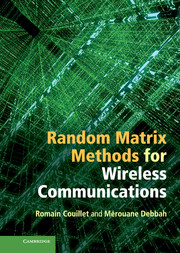Book contents
- Frontmatter
- Contents
- Preface
- Acknowledgments
- Acronyms
- Notation
- 1 Introduction
- Part I Theoretical aspects
- Part II Applications to wireless communications
- 11 Introduction to applications in telecommunications
- 12 System performance of CDMA technologies
- 13 Performance of multiple antenna systems
- 14 Rate performance in multiple access and broadcast channels
- 15 Performance of multi-cellular and relay networks
- 16 Detection
- 17 Estimation
- 18 System modeling
- 19 Perspectives
- 20 Conclusion
- References
- Index
16 - Detection
from Part II - Applications to wireless communications
Published online by Cambridge University Press: 07 October 2011
- Frontmatter
- Contents
- Preface
- Acknowledgments
- Acronyms
- Notation
- 1 Introduction
- Part I Theoretical aspects
- Part II Applications to wireless communications
- 11 Introduction to applications in telecommunications
- 12 System performance of CDMA technologies
- 13 Performance of multiple antenna systems
- 14 Rate performance in multiple access and broadcast channels
- 15 Performance of multi-cellular and relay networks
- 16 Detection
- 17 Estimation
- 18 System modeling
- 19 Perspectives
- 20 Conclusion
- References
- Index
Summary
In this chapter, we now address a quite different problem than the performance evaluation of data transmissions in large dimensional communication channel models. The present chapter, along with Chapter 17, deals with practical signal processing techniques to solve problems involving (possibly large dimensional) random matrix models. Specifically in this chapter, we will first address the question of signal sensing using multi-dimensional sensor arrays.
Cognitive radios and sensor networks
A renewed motivation for large dimensional signal sensing has been recently triggered by the cognitive radio incentive, which, according to some, may be thought of as the next information-theoretic revolution after the original work of Shannon [Shannon, 1948] and the introduction of multiple antenna systems by Foshini [Foschini and Gans, 1998] and Telatar [Telatar, 1999]. In addition to the theoretical expression of the point-to-point noisy channel capacity in [Shannon, 1948], Shannon made us realize that, in order to achieve high rate of information transfer, increasing the transmission bandwidth is largely preferred over increasing the transmission power. Therefore, to ensure high rate communications with a finite power budget, we have to consider frequency multiplexing. This constituted the first and most important revolution in modern telecommunications and most notably wireless communications, which led today to an almost complete saturation of all possible transmission frequencies. By “all possible,” we mean those frequencies that can effciently carry information (high frequencies tend to be rapidly attenuated when propagating in the atmosphere) and be adequately processed by analog and digital devices (again, high frequency carriers require expensive and sometimes even physically infeasible radio front-ends).
- Type
- Chapter
- Information
- Random Matrix Methods for Wireless Communications , pp. 393 - 420Publisher: Cambridge University PressPrint publication year: 2011
- 1
- Cited by



